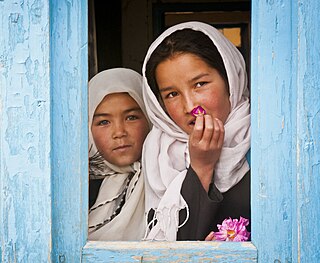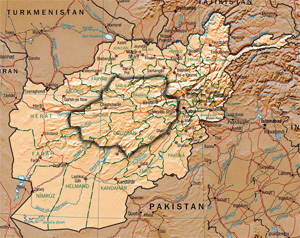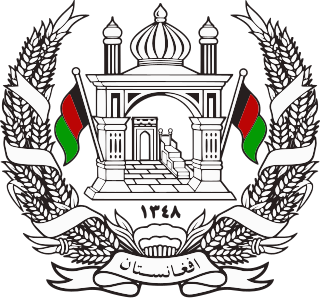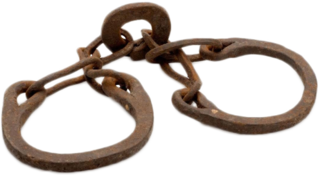
Abdur Rahman Khan also known by his epithets, The Iron Amir, was Amir of Afghanistan from 1880 to his death in 1901. He is known for perpetrating the Hazara Genocide, but also uniting the country after years of internal fighting and negotiation of the Durand Line Agreement with British India.

European influence in Afghanistan has been present in the country since the Victorian era, when the competing imperial powers of Britain and Russia contested for control over Afghanistan as part of the Great Game.

The Hazaras are an ethnic group and a principal component of the population of Afghanistan. They are one of the largest ethnic groups in Afghanistan and primarily residing in the Hazaristan (Hazarajat) region in central Afghanistan. Hazaras are also as significant minority groups in Pakistan mainly in Quetta and Iran mainly in Mashhad. They speak the Dari and Hazaragi dialects of Persian. Dari, also known as Dari Persian, is one of two official languages of Afghanistan.

Hazarajat, also known as Hazaristan is a mostly mountainous region in the central highlands of Afghanistan, among the Kuh-e Baba mountains in the western extremities of the Hindu Kush. It is the homeland of the Hazara people who make up the majority of its population. Hazarajat denotes an ethnic and religious zone.

The Kakar is a Gharghashti Pashtun tribe, based in Afghanistan, parts of Iran, and northern Balochistan in Pakistan.

The Second Anglo-Afghan War was a military conflict fought between the British Raj and the Emirate of Afghanistan from 1878 to 1880, when the latter was ruled by Sher Ali Khan of the Barakzai dynasty, the son of former Emir Dost Mohammad Khan. The war was part of the Great Game between the British and Russian empires.

The Treaty of Gandamak officially ended the first phase of the Second Anglo-Afghan War. The Afghan emir Mohammad Yaqub Khan ceded various frontier areas as well as Afghanistan's control of its foreign affairs to the British Raj.

The Ghiljī also spelled Khilji, Khalji, or Ghilzai and Ghilzay (غلزی), are one of the largest Pashtun tribes. Their traditional homeland is Ghazni and Qalati Ghilji in Afghanistan but they have also settled in other regions throughout the Afghanistan-Pakistan Pashtun belt. The modern nomadic Kochi people are predominantly made up of Ghilji tribes. The Ghilji make up around 20–25% of Afghanistan's total population.

The Barakzai dynasty, also known as the Muhammadzai dynasty, ruled what is now Afghanistan from 1823 to 1978, when the monarchy ended de jure under Musahiban Mohammad Zahir Shah and de facto under his cousin Sardar Mohammad Daoud Khan. The Barakzai dynasty was established by Dost Mohammad Khan after the Durrani dynasty of Ahmad Shah Durrani was removed from power. As the Pahlavi era in Iran, the Muhammadzai era was known for its progressivist modernity, practice of Sufism, peaceful security and neutrality, in which Afghanistan was referred to as the "Switzerland of Asia".
Pashtunization, is a process of cultural or linguistic change in which someone or something non-Pashtun becomes acculturated to Pashtun influence. Pashtuns are the largest ethnic group in Afghanistan and second-largest in Pakistan.
Hazara Town is a lower- to middle-income area on the western outskirts of Quetta, Pakistan, of which an almost all the residents are ethnic Hazaras, with a small population of Pashtuns and Baloch.
The Uruzgani are one of the major tribes of Hazara people. They mainly inhabit the Uruzgan Province and the present-day Daykundi Province. A 1965 work describes them as "sedentary agriculturalists... speak[ing] Hazaraghi."
Mariabad is an inner eastern suburb of Quetta, capital of Pakistan's Balochistan province.

Mohammad Nadir Shah was King of Afghanistan from 15 October 1929 until his assassination in November 1933. Previously, he served as Minister of War, Afghan Ambassador to France, and as a general in the Royal Afghan Army. He and his son Mohammad Zahir Shah, who succeeded him, are part of the Musahiban.

The Hazaras have long been the subjects of persecution in Afghanistan. The Hazaras are mostly from Afghanistan, primarily from the central regions of Afghanistan, known as Hazarajat. Significant communities of Hazara people also live in Quetta, Pakistan and in Mashad, Iran, as part of the Hazara and Afghan diasporas.
As a geographically fragmented state, Afghanistan is separated into as many as 14 ethnic groups that have historically faced divisions that devolved into political violence. This conflict reached its culminating point in the 1990s with the rise of the Taliban.

Slavery in Afghanistan was present in the post-Classical history of Afghanistan, continued during the Middle Ages, and persisted into the 1920s.
Starting in the 1880s, various Pashtun-dominated governments of Afghanistan have pursued policies, called Pashtunization, aimed towards settling more ethnic Pashtuns in the northern region of Afghanistan.
The Hazara genocide occurred in the aftermath of the Second Anglo-Afghan War when the Afghanistan Emirate signed the Treaty of Gandamak. Afghan Amir Abdur Rahman set out to bring the Turkistan, Hazaristan, and Kafiristan regions under his control. He launched several campaigns in the Hazarajat due to resistance to oppression from the Hazaras, culminating in the Battle of Uruzgan and he conducted a widespread genocidal campaign against its population.
The Revolt of Hasan Khan Salar(Persian: شورش حسن خان سالار) was a revolt that occurred in Khorasan from 1846 to 1850. It began as a result of the power struggle in the Qajar court. One of the factions manifested itself in Khorasan by Hasan Khan Salar. Salar's revolt sought to promote Bahman Mirza and his claim to power.













